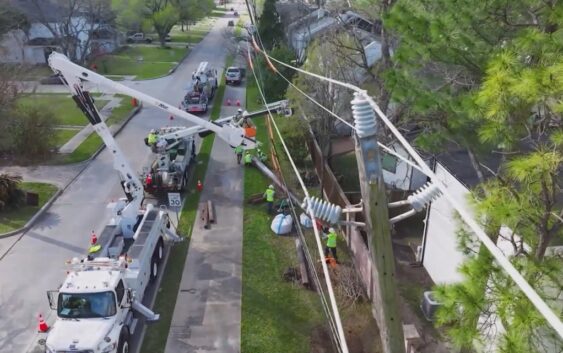- Eric Tulsky comfortable, confident and going for the Stanley Cup in 2nd year as Hurricanes GM
- 5 homes collapse into the surf of the Outer Banks as hurricanes rumble in Atlantic
- As hurricanes pass offshore, more Buxton homes collapse into the sea
- Central Texas floods reveal need to shore up disaster response in unincorporated areas
- Latest: Tropical Storm Imelda will pull away from East Coast, expected to become a hurricane
CenterPoint lays out storm response improvements in wake of Houston derecho, Hurricane Beryl

CenterPoint leaders acknowledged where things went wrong last year and laid out the steps they’re now taking to improve.
HOUSTON — One year after back-to-back storms left millions across Houston without power, CenterPoint Energy said it’s making changes to better prepare for the next major weather event.
At its first-ever Resiliency Technology Summit on Tuesday, company leaders acknowledged where things went wrong last year and laid out the steps they’re now taking to improve.
“We took those events really to heart, because we know we disappointed our customers, and they were frustrated with the experience during those events,” Monica Karuturi, CenterPoint Energy’s executive vice president and general counsel, said.
Last year’s derecho and Hurricane Beryl triggered widespread outages and a flood of complaints over slow updates and response times. CenterPoint leaders called it a wake-up call.
“All of that was a call to action for us to do better,” Karuturi said.
The company said it’s working with seven technology firms to strengthen the grid and avoid similar outages. Some of the upgrades already underway include:
- Installing more than 26,000 storm-resilient poles
- Clearing 6,000+ miles of vegetation near power lines
- Adding more than 5,150 automation devices to speed up restoration times
“To put that into perspective, Texas is about 775 miles wide at its widest point — we’ve done about 7x of that,” Keith Stephens, CenterPoint’s chief communications and marketing officer, said.
The utility company said its long-term goal is to build the most resilient power grid along the Gulf Coast.
When asked how the company plans to regain trust from frustrated customers, Stephens responded: “We heard the calls for change. We know we didn’t live up to expectations last summer. In response to Beryl, 2.2 million customers were out — that’s way too many customers out.”
For this hurricane season, CenterPoint said customers can expect:
- More mutual aid crews arriving earlier
- Faster safety training for workers
- Quicker estimates on power restoration
CenterPoint said those changes are already having an impact. According to the company, average outages from everyday storms are down from 81 minutes last year to 41 minutes now.
Much of that progress is credited to new partnerships, including:
Neara
Neara creates a digital twin of CenterPoint’s grid to simulate extreme weather and identify vulnerable points before a storm hits.
“Not only does it look like it, but it acts and reacts like it,” Rob Brook, Neara’s senior vice president, said. “The simulations we make are real time.”
Convey
Convey is a communications firm that helps the utility contact millions of customers by text, phone, or email within seconds.
“Whatever preference the customer has selected, they will get communicated to within a matter of seconds,” Maulik Datanwala, Convey’s CEO, said.
Pano
Pano AI’s 360-degree, high-definition cameras are designed to detect wildfires in real time. The same technology can also be used to monitor power lines, downed trees and storm-damaged areas to determine if it’s safe for crews to enter.
The cameras will be installed at 25 high-risk stations across Greater Houston later this year.
“We’re better prepared than last year, and we’re looking to get better every single day,” Stephens said.